Music Educators Association of New Jersey
Serving teachers and students since 1927



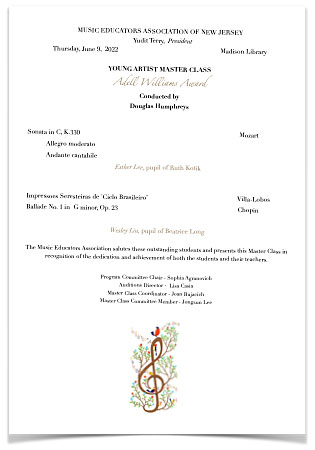 This last meeting of the year was another hybrid (actual and virtual) one, but the audience in the Chase room was almost as large as those pre- pandemic. President Yudit Terry conducted the voting for the slate of officers and the newly elected president, Danette Whelan, was applauded. Next, Programs Chair Sophia Agranovich introduced Dr. Douglas Humpherys with an abbreviated summary of his extensive career as soloist, teacher, international competition adjudicator, professor, and guest lecturer. He holds an M.M. degree from The Juilliard School and a D.M.A. from the Eastman School, where he serves as professor of piano following a twenty-year term as chair of the piano department. In 2013, Mr. Humpherys was appointed artistic director of the Gina Bachauer International Piano Competition, an institution that awarded him the gold medal in 1975, its initial year. For more information, please consult his website.
This last meeting of the year was another hybrid (actual and virtual) one, but the audience in the Chase room was almost as large as those pre- pandemic. President Yudit Terry conducted the voting for the slate of officers and the newly elected president, Danette Whelan, was applauded. Next, Programs Chair Sophia Agranovich introduced Dr. Douglas Humpherys with an abbreviated summary of his extensive career as soloist, teacher, international competition adjudicator, professor, and guest lecturer. He holds an M.M. degree from The Juilliard School and a D.M.A. from the Eastman School, where he serves as professor of piano following a twenty-year term as chair of the piano department. In 2013, Mr. Humpherys was appointed artistic director of the Gina Bachauer International Piano Competition, an institution that awarded him the gold medal in 1975, its initial year. For more information, please consult his website.
Annual Piano Auditions Chair Lisa Casia expressed gratitude to Joan Bujacich, her immediate predecessor, for assisting with the auditions and for coordinating the master class. Master Class Committee Member Jongsun Lee also thanked Joan.
Esther Lee, pupil of Ruth Kotik, performed the Allegro moderato and Andante cantabile of Mozart’s Sonata in C, K. 330. Her playing was outstanding in faithfulness to the score; every notation in dynamics and articulation was observed. She had a good sense of style. Douglas Humpherys made two general suggestions, both related to dynamics. First, he encouraged Esther to project the sound more, to be a bit bolder. Secondly, he suggested she consider a broader range of dynamics that would increase the possibilities of shaping melodic lines. Many pianists become preoccupied with the keyboard and their fingers; they fail to listen to the sounds emanating from the strings and soundboard beyond their sight. “Pay attention to the keyboard and the sound,” he advised. “Listen.”
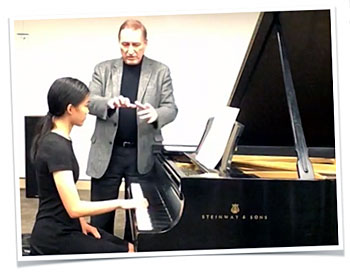 Mr. Humpherys stated that Mozart’s piano sonatas show the influence of opera. Playing some excerpts of first movements by Beethoven, he demonstrated how Beethoven uses keyboard patterns and techniques, and thematic fragmentation that are not suggestive of song. In contrast, he observed, Mozart’s piano sonatas are often reminiscent of operatic music. To support this remark, he played Mozart’s opening bars of several tuneful Allegro movements and cited the melodious second movement of Esther’s Mozart sonata. The lively first movement, with its snappy opening theme, is more like an overture to an opera.
Mr. Humpherys stated that Mozart’s piano sonatas show the influence of opera. Playing some excerpts of first movements by Beethoven, he demonstrated how Beethoven uses keyboard patterns and techniques, and thematic fragmentation that are not suggestive of song. In contrast, he observed, Mozart’s piano sonatas are often reminiscent of operatic music. To support this remark, he played Mozart’s opening bars of several tuneful Allegro movements and cited the melodious second movement of Esther’s Mozart sonata. The lively first movement, with its snappy opening theme, is more like an overture to an opera.
Examining the Allegro, he noted that the theme and other passages were repeated with some variation, and said it was important to be mindful of the details or the exact nature of these variations. The right hand can express these differences. Asking Esther to play the right hand alone, he cautioned her to play the repeated G’s musically, without accenting the third G, and to end the trill precisely. Think of the arpeggios in m. 5 and m. 6 as melodic lines and play them accordingly. Mm. 7 and 8 might be more expressive. He compared the repetition of ideas in m. 19 and m. 23, suggesting that repetition might be treated with more emphasis. “You can project musical ideas without being melodramatic,” he encouraged. Other sections, like mm. 32-34, are more dancelike. He marveled at how Mozart played around with the repeated G’s in the melody throughout the movement.
 Mr. Humpherys commented that when the thumb is played on the triangle of flesh behind the nail rather than on the side of the thumb, one is more likely to produce good melodic lines and less inclined to accent the thumb. He added that the staccato quarter note is different from a staccato eighth note.
Mr. Humpherys commented that when the thumb is played on the triangle of flesh behind the nail rather than on the side of the thumb, one is more likely to produce good melodic lines and less inclined to accent the thumb. He added that the staccato quarter note is different from a staccato eighth note.
Time constraints limited discussion of the Andante cantabile. We were reminded that the melodious theme could be an aria. Mr. Humpherys invited Esther to sing excerpts from this piece. The master teacher discussed the changes in tonality as one moves from section to section, and the consequent changes in expression that they generate. He thanked Esther Lee for her excellent performance and congratulated her teacher, Ruth Kotik.
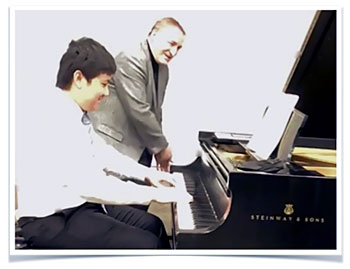 Wesley Liu, pupil of Beatrice Long, performed “Impressões Seresteiras” de Ciclo Brasileiro by Villa-Lobos, and Ballade No. 1 in G minor, Op. 23 by Chopin. These two pieces contrasted with each other and with the Mozart that we had just heard, making this master class repertoire particularly interesting. Humpherys reminded us that the music of this Brazilian is very different from that of Ginastera, an Argentinian. The piece opens with a sweeping bravura passage, boldly announcing the C-sharp minor tonality. The melancholic melody of “minstrel impressions” is then introduced in a quiet setting, its stepwise motion and repeated rhythmic pattern calming. It ends with a flourish, followed by two loud sections of various repeated rhythmic patterns separated by a third sweeping bravura passage including tremolos of chords. These three elements, mournful tune, rhythmic loud chords and octaves, and sweeping bravura flourishes are repeated with increasing excitement until the closing Moderato, rallentando.
Wesley Liu, pupil of Beatrice Long, performed “Impressões Seresteiras” de Ciclo Brasileiro by Villa-Lobos, and Ballade No. 1 in G minor, Op. 23 by Chopin. These two pieces contrasted with each other and with the Mozart that we had just heard, making this master class repertoire particularly interesting. Humpherys reminded us that the music of this Brazilian is very different from that of Ginastera, an Argentinian. The piece opens with a sweeping bravura passage, boldly announcing the C-sharp minor tonality. The melancholic melody of “minstrel impressions” is then introduced in a quiet setting, its stepwise motion and repeated rhythmic pattern calming. It ends with a flourish, followed by two loud sections of various repeated rhythmic patterns separated by a third sweeping bravura passage including tremolos of chords. These three elements, mournful tune, rhythmic loud chords and octaves, and sweeping bravura flourishes are repeated with increasing excitement until the closing Moderato, rallentando.
 Wesley was asked to play the opening melody and the bass line, omitting the inner voice, to hear the counterpoint. Professor Humpherys played an excerpt of Schubert’s Impromptu No. 3, Op 90, illustrating how the G-flat major chord followed by E-flat minor affects the unchanging B-flat in the melody. He emphasized that sometimes it is essential to project the bass.
Wesley was asked to play the opening melody and the bass line, omitting the inner voice, to hear the counterpoint. Professor Humpherys played an excerpt of Schubert’s Impromptu No. 3, Op 90, illustrating how the G-flat major chord followed by E-flat minor affects the unchanging B-flat in the melody. He emphasized that sometimes it is essential to project the bass.
Douglas Humpherys recommended thinking of the pulse in mm. 6-9 in “hypermeter,” that is, count only the first beats. The four measures will be counted: one, two, three, four, with counts one and three being stronger than counts two and four. Continue counting in hypermeter until m. 25. When executing the sweeping bravura passages, use more finger motion to gain control, to articulate more clearly, and to play softer. He likened this skill to that of the card dealer who quietly shuffles his deck, and you can hear each card shifting. He reminded Wesley of his suggestion to play the thumb on the fleshy triangle behind the nail rather than the side of the thumb. At m. 81, and all measures with a like pattern, hold the quarter note on the third count for its full value. When arriving at m. 85, a more ponderous treatment of the same pattern, treat the two eighths and a quarter note on second and third counts with one bouncing [arm] gesture instead of three. “You are playing with great passion, but there can be more!”
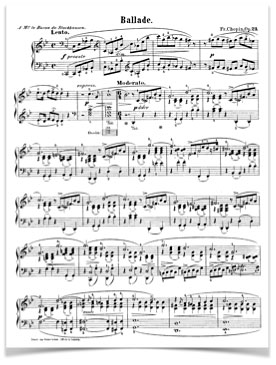 On to the Chopin Ballade in G minor. We might imagine a story this piece tells. The opening is striking: an A-flat arpeggio from bass to soprano register in 4/4 meter, then a change to 6/4 meter with the theme. Count carefully. All four ballades are written in 6/4. Do not think that one measure is equivalent to two measures in waltz time, although “there is a little waltz in so many works of Chopin.”
On to the Chopin Ballade in G minor. We might imagine a story this piece tells. The opening is striking: an A-flat arpeggio from bass to soprano register in 4/4 meter, then a change to 6/4 meter with the theme. Count carefully. All four ballades are written in 6/4. Do not think that one measure is equivalent to two measures in waltz time, although “there is a little waltz in so many works of Chopin.”
When playing the opening bars, transfer the weight from key to key. Wesley was asked to stand and “play” the passage on his piano bench cushion to feel the weight of his arms shift, finger to finger. Maintain the tone quality until the diminuendo in the third measure. At m. 30, do not rush. The next measure has a ritenuto. Maintain this held back pace until the return to a tempo at m. 36. In m. 32, treat the melody carefully, articulating and also shaping the elaborate line. 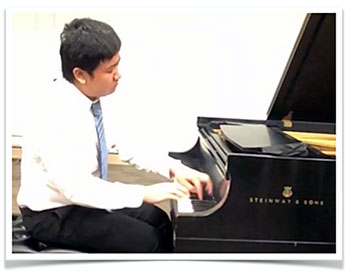 Practice the left hand alone in mm. 36-44. Then share these left hand notes with the right hand, playing the bass with the left and the chords with the right. The inner voices and the harmonies will be clearly heard. When tackling the right hand keyboard gymnastics at m. 48, try practicing it staccato and “grab” the double notes as they occur. Although time did not permit discussion of the entire ballade, the many suggestions offered would help Wesley bring his performance to an even higher level. Bravo, Wesley! Brava, Beatrice Long!
Practice the left hand alone in mm. 36-44. Then share these left hand notes with the right hand, playing the bass with the left and the chords with the right. The inner voices and the harmonies will be clearly heard. When tackling the right hand keyboard gymnastics at m. 48, try practicing it staccato and “grab” the double notes as they occur. Although time did not permit discussion of the entire ballade, the many suggestions offered would help Wesley bring his performance to an even higher level. Bravo, Wesley! Brava, Beatrice Long!
Lisa Casia emphasized that these winners of the Adell Williams Award had each prepared a full program. She congratulated the two winners and their teachers and presented Esther and Wesley with their certificates.

Bertha Mandel, writer
Lisa Gonzalez, screen shots, layout
Joan Bujacich, master coordinator